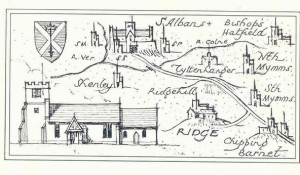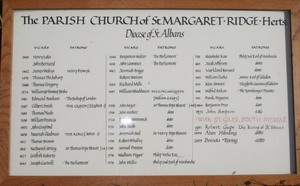St Margaret’s History
St Margaret’s: A brief history
THE PARISH
Ridge Parish was formed in the late 13th century of lands belonging mainly to St. Albans Abbey. Until 1870, the parish remained in the Liberty of St Albans. From 1870 it has formed part of Hertfordshire. Up to 1956, the parish included a detached area between Borehamwood and Shenley; this may be what the Doomsday Book of 1086 refers to as ‘the Abbotts land at Shenlai’. The parish consists of approximately 3000 acres of Green Belt land; in 1981 the population was still only 300. The parish is over six miles long, running from Galley Lane, Arkley, to Colney Heath.
THE CHURCH
The chancel dates from the 14th century, and probably formed a tiny church on its own. The Roman road from London to St Albans passed nearby, and the church may have been intended as a landmark for those entering the domain of the Abbot. The nave and tower were added in the 15th century. The church was extensively decorated with wall paintings, of which one complete example survives. This is of St. Christopher carrying our Lord across a river dates from the 15th century, probably by the same hand as the wall paintings of this date in St Albans Abbey. It was restored by Professor Tristram in 1937, and has since received further treatment. A detailed description can be seen on the adjacent window cill.
In 1740-46 major repairs were carried out and the church furnished with box pews and a three-decker pulpit. In 1810, a gallery was placed at the west end and dormer windows inserted into the roof. The church was again restored in 1881, when ceilings, gallery and dormer windows were removed, the porch rebuilt, and a new arch cut between nave and chancel, destroying most of a medieval doom-painting which survived under the whitewash. Since 1945, further repairs have been carried out, including the re-flooring and re-furnishing of the chancel. The roof was renewed in 1976, and the stonework of the tower repointed and partially replaced in the 1980s. Before applying new limewash in 1989, examination of the remaining fragments of medieval wall-painting was carried out, but nothing was found extensive enough to warrant restoration.


